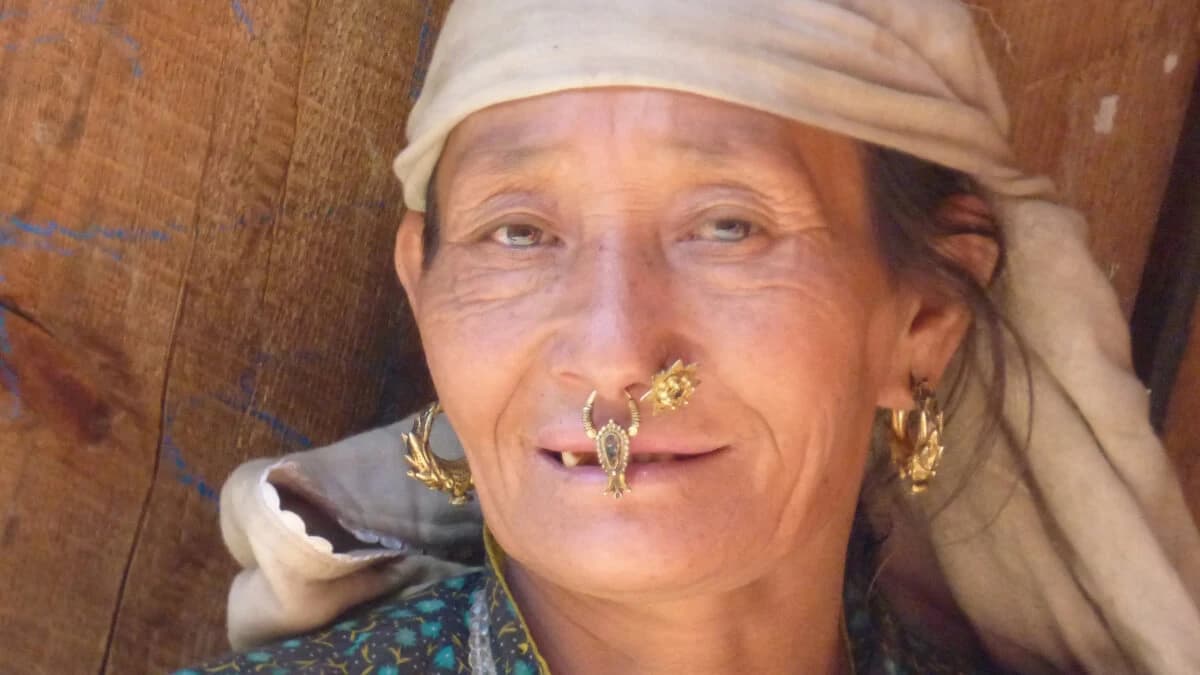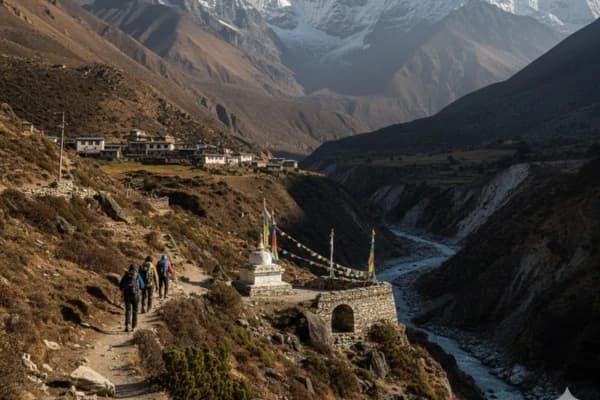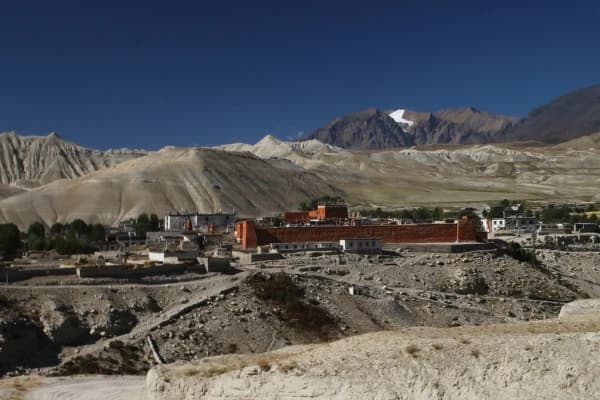In this blog, we’ll explore the fascinating people of the Himalayas, from their culture and customs to their lifestyle and challenges. By the end of this post, you’ll have a deeper understanding of who the people of the Himalayas are and what makes them so unique.
People of the Himalayas: Culture, Location and Uniqueness
The Himalayas are one of the world’s most iconic mountain ranges, stretching across five countries in South Asia: Nepal, India, Bhutan, China, and Pakistan. This vast range is home to some of the planet’s highest peaks, including Mount Everest, which towers over the world at 8,848 meters (29,029 feet).
The Himalayas have long captured the imagination of adventurers, spiritual seekers, and nature lovers.
Thankfully, the Himalayas are more than just a group of majestic mountains on a map; they are full of legends, customs, and inhabitants. Centuries have been inspired by these mountains in how they celebrate, live, and interact with the world. The Himalayas are more than just a landscape to those who live there; they are a way of life.
From the Sherpas who guide mountaineers to the farmers cultivating high-altitude crops, the people of the Himalayas have adapted uniquely to this challenging yet majestic environment.
Where Are the Himalayas Located?
The Himalayas, also known as the "abode of snow," are located in South Asia. They stretch across five countries: Nepal, India, Bhutan, China, and Pakistan. The range extends over 1,500 miles (2,400 km), creating a natural barrier between the Indian subcontinent and the Tibetan Plateau.
The highest point in the Himalayas, Mount Everest, stands at 8,848 meters (29,029 feet), making it the highest mountain in the world.
The Himalayas are not just a stunning row of mountains—they're nature's great divider. To the east is the fertile plain of the Indian subcontinent; to the west, the rolling, windy Tibetan Plateau. Nature's division has resulted in totally different landscapes, cultures, and lifestyles on either side of the mountains.
The Himalayas are also home to some of the world’s most famous trekking routes, including the Everest Base Camp Trek and the Annapurna Circuit Trek, attracting thousands of tourists every year.
The range spans several regions, from the dense jungles of the lower foothills to the rugged, snow-capped peaks at higher elevations. Each region has its own unique culture and way of life, with the people of the Himalayas adapting to their environment in remarkable ways.
Fascinating Facts About the Himalayas
The Himalayas are a source of wonder, mystery, and inspiration. Here are some fascinating facts about the region:
- Home to the World’s Tallest Peaks: The Himalayas are home to many of the highest mountains in the world, including Mount Everest, K2, and Kanchenjunga. These peaks have inspired generations of mountaineers and adventurers.
- Sacred Ground: Many of the mountains in the Himalayas are considered sacred in both Hinduism and Buddhism. Mount Kailash, for example, is regarded as the home of Lord Shiva by Hindus and is an important pilgrimage site for Buddhists.
- Diverse Wildlife: The Himalayas are a biodiversity hotspot, home to species in danger like snow leopards, red panda, and Himalayan tahr. The region also boasts an enormous variety of plant species, a large number of which have traditional medical applications.
- A Crucial Water Source: The Himalayas serve as the source of major rivers, including the Ganges, Brahmaputra, and Indus, which provide water to millions of people in the region.
- Cultural Diversity: The Himalayas are home to several ethnic groups, each with its own distinct culture, language, and traditions.
The People of the Himalayas: Tribes and Ethnic Groups
The people of the Himalayas are as diverse as the mountains themselves. The region is home to several ethnic groups, each with its own unique traditions, lifestyles, and languages. Some of the well-known groups include the Sherpas, Tamangs, Gurungs, and Limbus, but there are many others who have lived in the region for centuries.
Sherpas: The Mountain Guides

The Sherpas are perhaps the most famous ethnic group from the Himalayas. Known for their exceptional mountaineering skills, Sherpas are instrumental in helping mountaineers reach the summit of Everest and other high peaks. Sherpas are originally from Tibet and have lived in the mountains of Nepal for centuries.
Sherpas are known for their incredible ability to endure the high-altitude environment. Their bodies are naturally adapted to the thin air, which gives them a stamina that is unmatched by people from lower altitudes. Many Sherpas work as guides, porters, and cooks for trekking expeditions, earning a living by assisting climbers and trekkers who visit the region.
In addition to their mountaineering skills, Sherpas have a deep spiritual connection to the mountains. They practice Tibetan Buddhism, and many Sherpas live in small villages in the Khumbu Valley, near the base of Mount Everest. They celebrate festivals like Lhosar (Tibetan New Year) with family and friends, often featuring traditional dance, music, and feasts.
Tamang People
The Tamangs are another prominent ethnic group in the Himalayas. Predominantly found in Nepal, particularly in the central regions, the Tamangs are known for their agricultural lifestyle. They live in terraced villages high up in the mountains, where they farm crops like barley, rice, and millet.
The Tamangs are also followers of Tibetan Buddhism and have a rich cultural heritage. The Tamangs share the same profound regard for mountains as the Sherpas and tend to conduct religious rituals and ceremonies to preserve nature. Their clothing, the detailed artwork, and the music all echo their culture.

Gurungs, Limbus, and Other Ethnic Groups
Only a few other important ethnic groups of the Himalayas include the Gurungs, Limbus, and Magars. The Gurungs, for example, are well known for their skills in martial arts and for being skilled in the art of war, having been traditional soldiers in the British and Indian armies.
The Limbus, another group found primarily in eastern Nepal, are known for their strong community ties and deep respect for nature. They practice a unique form of animism, believing that the natural world is inhabited by spirits that must be respected and honored.
Religion and Spiritual Life
Religion has a significant impact on the lives of the people in the Himalayas. Both Hinduism and Buddhism are widely practiced in the region, with some areas being predominantly one or the other.
Hinduism in the Himalayas
Hinduism is the dominant religion in much of the lower regions of the Himalayas. For Hindus, the mountains are sacred, and many of the peaks are believed to be the homes of gods. Mount Kailash, for example, is considered the home of Lord Shiva, one of the most important deities in Hinduism. Pilgrims from all over India and beyond travel to the Himalayas to visit sacred sites and perform religious rituals.
Buddhism in the Himalayas
Buddhism is more prevalent in the higher altitudes of the Himalayas, especially in regions like Tibet, Bhutan, and parts of Nepal. Tibetan Buddhism, in particular, has a strong presence in the region. Monasteries and stupas dot the landscape, and prayer flags flutter in the wind, offering prayers to the gods.
Buddhism and the natural world are closely related, as many of its teachings emphasise how all living things are interdependent. In order to achieve inner calm and spiritual enlightenment, the people of the Himalayas frequently engage in rituals, meditation, and prayer.
Traditional Culture, Dress, and Art
Most ethnic groups have contributed to the Himalayas' special and diverse culture. The traditional clothing, artwork, and architectural styles all reflect the region's unique climate, topography, and religious beliefs.
Traditional Clothing
Himalayan attire is designed to heat people up during the cold, high-altitude environment. Sherpas, for example, wear thick woolen topcoats and leggings, typically constructed of yak wool. They are not only practical but also beautifully ornamented with intricate patterns and motifs that represent the wearer's cultural heritage.
Art and Craft
Himalayan art has a strong religious connection. Buddhist thangkas, for instance, use bright colors and detailed patterns to produce elaborate portraits of gods and religious icons. Metalwork is another significant heritage, wherein skilled craftsmen produce beautiful statues, prayer wheels, and other religious objects.
In addition to religious art, the people of the Himalayas are skilled in creating textiles, including woolen rugs, carpets, and blankets. These handcrafted items are often passed down through generations, preserving the cultural heritage of the region.
Celebrations and Festivals in the Himalayas
The festivals of the Himalayas are an important aspect of the region’s culture. These celebrations are a time for people to come together, honor their traditions, and celebrate their spiritual beliefs.
Lhosar (Tibetan New Year)
Lhosar is the Tibetan New Year, celebrated by the Sherpas and other Tibetan Buddhists in Nepal. The festival marks the beginning of the new year in the lunar calendar and is a time for family gatherings, feasts, and prayers. Lhosar is a joyful occasion, with traditional dances, songs, and the wearing of colorful garments.
Dashain and Tihar
Dashain and Tihar are common Nepalese and neighboring regions Hindu festivals. Dashain is a festival of sacrifices to the gods and family gatherings, while Tihar or the festival of light is a celebration of victory over evil.

Buddhist Festivals
In addition to Lhosar, the other Buddhist holidays are also being celebrated in the Himalayas, including the full moon holiday, which is used to mark the Buddha's birth, enlightenment, and death. These holidays are being celebrated by praying, offering rituals, and lighting butter lamps.
Challenges in Preserving Himalayan Culture
While the people of the Himalayas have managed to preserve much of their traditional way of life, the region faces numerous challenges that threaten its cultural heritage.
Tourism and Modernization
Tourism has brought both positive and negative effects. On the positive side, it has generated economic potential, while on the negative side, it has led to local traditions becoming commercialized and extended modern infrastructure into distant parts of the world. This has challenged cultural authenticity as well as sustainability in the environmental context.
Environmental Threats
Deforestation, the consequences of climate change, and glacier melting are just a few of the serious environmental problems facing the Himalayas. The livelihoods of those who rely on agriculture, livestock, and natural resources are impacted by these changes.
Preservation Efforts
Plans to promote sustainable tourism, preserve holy places, and revive traditional arts are part of the area's cultural conservation agenda. In addition, organisations are trying to make sure that Himalayan people can still live in an environmentally friendly way as they adjust to contemporary challenges.
Conclusion:
The Himalayan people live in one of the most stunning and challenging climates in the world. Their spiritual beliefs, traditions, and cultures are intrinsically connected to the mountains, and their resilience and adaptability have allowed them to endure such a challenging environment. We venture deeper into the Himalayas, let us not forget that its culture is not just about how beautiful it is, but also about the people who have settled this land for centuries, and a way of life as enduring as the mountains themselves.
Are you ready to experience the culture and beauty of the Himalayas for yourself? Discover amazing trekking packages to explore this magical region. Contact us today to book your next Himalayan adventure!
FAQ’s
Who are the people of the Himalayas?
The Himalayas are home to a mix of ethnic groups who’ve lived in the region for centuries. Communities like the Sherpas, Tamangs, Gurungs, Ladakhis, and Bhutias each have their own languages, clothing, food, and beliefs. Their lives are shaped by the mountains—they farm, trade, herd animals, and follow customs passed down through generations.
What languages are spoken in the Himalayas?
You’ll hear a variety of languages depending on where you are. Nepali is widely spoken in Nepal, while Tibetan is common in areas like Ladakh and Bhutan. Ethnic groups speak their own languages—like Sherpa, Tamang, and Gurung—and in many villages, people are fluent in multiple dialects.
What religions are practiced in the Himalayas?
Hinduism and Buddhism are the two main religions, often blending together in daily life. You’ll see prayer flags fluttering from rooftops, small shrines along trails, and locals celebrating religious festivals with devotion. Some communities also follow animist or shamanic traditions tied to nature and ancestral spirits.
Where exactly are the Himalayas located?
The Himalayas stretch across a large part of South Asia, forming a natural border between the Indian subcontinent and the Tibetan Plateau. They span five countries—Nepal, India, Bhutan, China (specifically the Tibet Autonomous Region), and Pakistan.
What makes Himalayan culture unique?
It’s deeply rooted in the environment. People have adapted to harsh mountain conditions while preserving strong spiritual and communal traditions. The mix of Buddhist and Hindu influences, along with local customs and stories, gives Himalayan culture a depth you won’t find anywhere else.
What is life like in Himalayan villages?
Life is tough but grounded. People grow their own food, keep livestock, and rely heavily on family and neighbors. There’s a strong sense of community. Modern comforts are limited in many areas, but the pace is slower, and life stays closely tied to nature and seasonal rhythms.
What challenges do Himalayan communities face today?
Glaciers are melting, weather patterns are changing, and traditional ways of life are being disrupted. Younger generations often move to cities, leaving behind aging rural populations. Tourism brings opportunity but also puts pressure on the environment and local culture.
Are Sherpas the only mountain guides in the Himalayas?
Sherpas are the most famous—especially in Nepal—because of their skill at high altitudes and deep knowledge of the mountains. But they aren’t the only guides. Other groups like the Tamangs and Gurungs also work as porters and guides, and in regions like Ladakh or Bhutan, locals lead treks as well.
What kind of festivals are celebrated in the Himalayas?
Festivals vary by region and religion. Lhosar (Tibetan New Year) is big in Buddhist communities. Hindus celebrate Dashain and Tihar with family feasts, music, and rituals. These events aren’t just religious—they’re also a chance to come together, share food, wear traditional dress, and celebrate life.
Can I visit and experience Himalayan culture firsthand?
Yes, and it’s well worth it. Whether you trek to a remote village, stay in a local homestay, or join a festival, you’ll get a real sense of how people live and what matters to them. Respectful travel—where you slow down, listen, and engage—can offer deep and memorable experiences.




